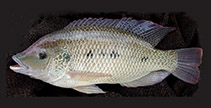| Diagnosis: |
Dorsal spines (total): 15-18; Dorsal soft rays (total): 11-15; Anal spines: 3-3; Anal soft rays: 9-13; Vertebrae: 30-32. Diagnosis: male genital papilla bluntly conical with a narrow flange slightly notched in the middle; jaws enlarged in breeding males, which in this species are normally not less than 30cm TL; scales in lateral line series 31-35, usually 32-33; scales of cheek in 3 full rows; vertebrae 30-32; total number of dorsal rays 28-31. Pectoral fin in adults 34-43% SL (Ref. 2), very long (Ref. 1904). Depth of body 40.5-50.5% SL; color-pattern of non-breeding fish and female always including 3 or 4 conspicuous mid-lateral blotches and a red margin on dorsal and caudal fins; breeding male with red margins broader and brighter and general dark, iridescent purplish-brown color of head, back and flanks, masking the blotches; no series of vertical spots or vertical stripes on caudal fin; nest a simple circular depression (Ref. 2).
Description: deep bodied (Ref. 12524, 13337, 52307, 54048) with a straight profile (Ref. 1887, 2989, 6465, 12524, 13337, 52307, 54048). Snout rounded (Ref. 1887, 2989). Small mouth (Ref. 12524, 13337, 13400), extending to between nostril and eye (Ref. 2989). Lower pharyngeal bone slender (Ref. 54096). Teeth slender, not densely crowded (Ref. 2, 54096), the posterior with a marked second cusp or shoulder; inferior vertebral apophysis only on third vertebra; microbranchiospines present on the outer sides of arches 2 to 4; 5-8 scales between bases of pectoral and pelvic fins; caudal fin only scaled at the base (Ref. 2). Caudal fin with 15 rays (Ref. 1904). Adult large males have the posterior rays of the dorsal fin prolonged (Ref. 12524, 13337). Pectoral fin reaching vertical of origin of anal; pelvic fin reaching between vent and anal; caudal fin rounded; scales cycloid (Ref. 1887, 2989).
Coloration: body silvery-grey with upper parts of head and body darker than ventral parts (Ref. 2, 52307). Dorsal fin light green to brown Ref. 12524, 13337). Pectoral (Ref. 1904, 12524, 13337) and pelvic fins light grey (Ref. 1904) to green; anal fin grey to green at its base (Ref. 12524, 13337). Margins of dorsal and anal fin bright red (Ref. 2, 6465, 7248, 12524, 13337, 52193, 52307). Soft portions of dorsal and anal fins with pale tips and dots (Ref. 2, 1887, 1904, 2989, 6465, 7248, 52193) that are also sometimes visible in the caudal fin (Ref. 2, 52307). 3 prominent black spots present on flanks (Ref. 2, 1887, 2989, 6465, 12524, 13337, 54048) and a black patch on the posterior portion of the gill cover (Ref. 2, 1887, 2989, 12524, 13337, 54048). The 3 body spots are usually visible from an early age (Ref. 12524, 13337), and are more pronounced in small specimens (Ref. 6465). In breeding males body and fin colours become brighter, with the red seams on the fins becoming more intense (Ref. 2, 7248, 12524, 13337, 52193, 52307) and the snout and cheeks assume a deep maroon coloration (Ref. 12524, 13337, 54048). The caudal fin may appear totally red (Ref. 52307). Juveniles silvery with 6-9 irregular thin bars on body (Ref. 6465, 7248, 12524, 13337, 52193) and 3-4 midlateral spots (Ref. 13337). Young with Tilapia-mark, which disappears or becomes part of the barred pattern of the fin at ca 7cm SL; up to ca 10cm SL vertical bars on the body may predominate and the mid-lateral spots may be faint or absent; 6-10 faint vertical bars appear in dead fish (Ref. 2). |
| Biology: |
Occurs in both river and swamp habitats and is adapted to fairly fast-flowing rivers (Ref. 6465). Hardy, tolerating fresh and brackish water (up to 20ppt, Ref. 3), preferring slow-flowing or standing water; adults occupy deep open waters, juveniles remain inshore among vegetation (Ref. 7248, 52193). Prefers fairly deep, quiet water with some weed cover; hippo pools are a favoured retreat (Ref. 12524, 13337). Forms schools (Ref. 2, 12524, 13337). Mainly diurnal; a detritivore which feeds on fine particulate matter (Ref. 2), including algae (Ref. 246, 12524, 13337, 53992), diatoms, detritus (Ref. 7248, 52193, 53992) and zooplankton (Ref. 7248, 52193). Larger individuals also take insects and other invertebrates (Ref. 53992). Feeding regime is variable, the diet changes according to food availability (Ref. 6465). Female mouthbrooder (Ref. 87, 246, 6465, 12524, 13337). Fine angling and table species (Ref. 6465, 12524, 13337). |

